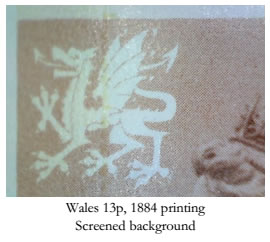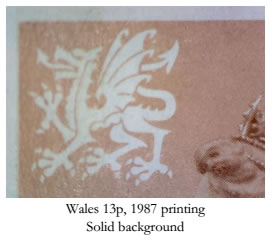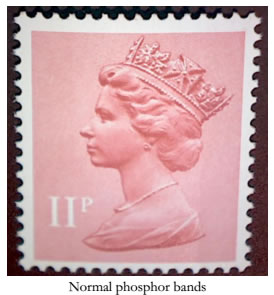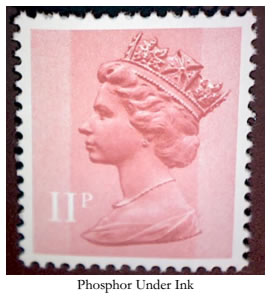Machin Study Group
Meeting of May, 6, 2014
Click Here >> For A PDF Copy Of These Meeting Minutes
Members present: Frank A.; Dan B.; Norma B.; Peter B.; Reay C.; Jim C.; David G.; Don H.; Peter J.; John L.; David M.; Jorge M.; Garfield P.; Ted S.; Vijay V.; Tom W.
David G. welcomed the group and called the meeting to order.
Vijay and Jim C. provided coffee and cookies
Don H. was acclaimed as the recording secretary for the meeting.
A quick poll revealed that we are expecting five members to produce single page exhibits for a group entry in the West Toronto competition next Tuesday.
Jorge announced that he had been sorting his Wales 13p and noted that a high proportion appeared to be printed by photogravure but catalogues indicate that both printings were lithography by Questa. The question had been posed to Garfield via email. Garfield discussed his research in the matter advising that the Stanley Gibbons catalogue reports that the first printings of the Wales 13p and 17p were both lithographed but the background was screened giving the appearance of a photoengraved stamp. Samples of both printings were circulated. The listings are all correct and everyone knows how to identify the two printings.


Jim C. showed a 4p turquoise stamp with phosphor bars that appeared to be “whiteish” and asked if anyone could explain. Garfield suggested that it looked like a “phosphor under ink” printing. A check of the Deegam catalogue does not show PUI for any of the 4p turquoise. The mystery is unresolved. If anyone has an answer, please let Garfield know and the report will be distributed.
During the above noted discussion, it was revealed that many members of our group had never heard of “Phosphor Under Ink” . The following description is taken directly from the Glossary in the Deegam catalogue.
“Phosphor Under Ink*. Because of a heavy commitment of the Jumelle press to special issue stamps,
the Halley press was modified to take a Jumelle colour cylinder as well as the normal Thrissell
cylinder for the phosphor. This resulted in certain values being printed with the phosphor under,
instead of over, the colour in 1974 and 1977. A similar thing occurred on certain printings on the
Jumelle press in 1978 and 1982 when there was only one unit free. This was used twice, the phosphor
being printed first (the cylinder number appearing inverted in the right margin instead of upright in
the left margin). These PUI issues illustrate the vicissitudes of modern high volume printing. PUI
stamps are best identified by holding them up to a strong light when the area of the bands will appear
significantly lighter than the rest of the stamp, even on the darker values. Those areas were sealed by
the phosphor ink, causing the subsequent application of colour to be absorbed less than in the rest of
the stamp. * The term PUI is really a misnomer because both the colour and the phosphor are inks but the term is
too well established to alter it. Perhaps phosphor under pigment may have made a more memorable acronym.


This discussion provided a perfect introduction to the evening’s feature presentation – a PowerPoint presentation by David G. discussing the various configurations of phosphor bands on the Machins.
This show created an awareness of the various types of phosphor bands including short bands, indented bands, single bands, two bands, etc. For those who had not studied the subject this was a real eye opener. The group consensus was that the presentation was very well done and that others of a similar nature would be welcomed.
Thank you David. Job well done!
The presentation, in its entirety, can be seen on the WTSC website at this link shown below -
Click Here >> Phosphor Bands : Short, Inset and Notched Bands Presentation by David Gooderham
Garfield recommended that members of the group should read the book “A TIMELESS CLASSIC – THE EVOLUTION OF MACHIN’S ICON” by Douglas Muir. The book is available in the Harry Sutherland Library at the Greene Foundation.
There was a brief discussion on gum types following a question by Jim C. This may well be the subject of a future PowerPoint presentation.
Upcoming Events
May 13, 2014 – West Toronto Stamp Club annual competition. Submissions are entered in the Single Page class for the Alusio Award, Single frame for the Drake Trophy and “anything goes” for the Ted Allan Cup.
May 28, 2014 – GTAPA Annual meeting held at the Greene Foundation at 7:00 pm. Everyone is welcome and encouraged to bring a single page exhibit for a fun competition. Let’s let the rest of the GTAPA membership know that the Machin Group is “alive and well”.
Next Meeting will be held June 3, 2014. Part of the program will feature a discussion of “What do we want for the 2014-15 series of meetings?” Please consider your wants and needs and be prepared to suggest them at this meeting.
Thanks everybody
Garfield
